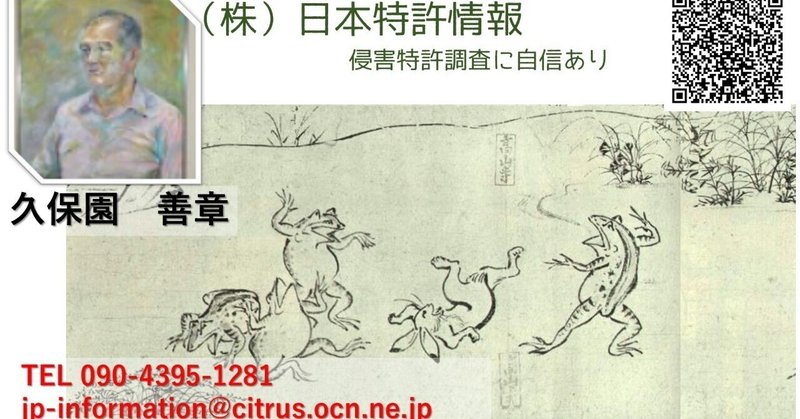
原告の請求棄却(原告=シャープ株式会社の権利無効)。 東京地方裁判所により「権利無効」とされた新87件目です。
https://drive.google.com/file/d/1e53nGKa6W8XHDH1xITASMO4icnn44gXB/view?usp=sharing
特許権者である原告のシャープ株式会社は、自分が保有する特許第5,379,269号(受信装置および受信方法)について、その特許の「有効性」を検証したか不明です。
「有効性」とは、自社の特許についての、例えば「無効資料調査」等を行うことで、たとえ利害関係者などの第三者からの「無効審判」を起こされても、自社の特許は盤石であると確信することです。
それにも拘らず、シャープ株式会社は、特許庁より与えられた特許を有効と信じて、オウガ・ジャパン株式会社を特許侵害している、と提訴しました。
しかしながら、東京地方裁判所は「本件訂正発明は乙1発明に基づいて,容易に発明し得たものであるから,進歩性を欠くものである(特許法29条2項)。したがって,本件特許は,本件訂正がされたとしても,特許無効審判により無効とされるべきものである」とし、結局、原告は敗訴しました。
また、その根拠として、被告であるオウガ・ジャパン株式会社が提示した「乙1発明」(IEEEに記載の論文)を先行技術文献として挙げています。
この文献「乙1発明」(IEEEに記載の論文)は、審査段階では見つけることが出来なかったものです。
そして、この文献「乙1発明」(IEEEに記載の論文)は、特許庁の審査官が独自に見つけた非特許文献とは異なるものです。
なお、IPCC(工業所有権協力センター)の検索者(L543)は、審査官に特許文献9件を提示しました。
審査官はそのうち4件を出願人に引用文献として示しましたが、これらは裁判所では相手にされない、弱いものと思われます。
特許庁の審査官のいい加減な判断に基づいた、特許付与は許されません。
それにしても、審査官の非特許文献、特に外国の非特許文献についての調査能力は低いですね。
従って、本来なら、シャープ株式会社の出願に対して、特許庁は特許を与えるべきでなかった、と考えます。
ここで、本件特許公開(特開2012-213215)の「出願情報」のうち「FI」と「Fターム」を、本エクセル資料の2シート目以降に挙げておきました。
ちなみに、本件特許(特許5379269)は、(無効審判2020-800071)として「オッポ広東移動通信有限公司」が審判を請求しています。
この審判に関する途中経過の書類はほとんど非公開のため、その内容を知ることは出来ませんが、一部である「審理事項通知書」がありましたので添付しておきます。
なお、請求人は途中で請求を取り下げています。
一方、東京地方裁判所における「令和2年(ワ)第2146号」は、特許権者である原告の敗訴が決まりましたが、知的財産高等裁判所へ控訴したかどうかは不明です。
多分、控訴はしていないように思われます。
しかしながら、特許庁の特許原簿には、「本権利は抹消されていない 存続期間満了日(2025/10/28) 」とあります。
東京地方裁判所により「特許無効審判により無効とされるべきものである」との判断が下されても、「本権利は抹消されていない 。」との状況下にあるようです。
ここで強調したいのは、「行政」(特許庁)としては、「司法」(裁判所)により誤りを指摘されたことを謙虚に反省し、その誤りを正すことを心掛けるべきです。
更にまた、「検索用語・分類(FI、Fターム)の選定 と 検索論理式の作成」、「その具体例」、「登録調査機関の検索者が行った、不十分で、的外れな「論理検索式」による(サーチ)」、「登録調査機関(株式会社AIRI)の検索者が見つけることのできなかった特許文献」などの資料を添付します。
https://drive.google.com/file/d/1Q3hHuHFHCHNlr3A0CRYVKYfpiNTPWUjB/view?usp=sharing
(Google Translation)
Plaintiff's claim dismissed (plaintiff=Sharp Corporation's rights invalidated).
This is the 87th new case that has been declared "invalid" by the Tokyo District Court.
It is unclear whether Sharp Corporation, the patentee and plaintiff, has verified the "validity" of its patent No. 5,379,269 (receiving device and method).
"Validity" means that even if an "invalidation trial" is filed by a third party such as an interested party, the company's patent will remain valid by conducting, for example, "invalidation material investigation" regarding the company's patent.
Be sure that it is rock solid. Despite this, Sharp Corporation believed that the patent granted by the Japan Patent Office was valid and sued Ogre Japan Corporation for patent infringement.
However, the Tokyo District Court held that ``Since the corrected invention could have been easily invented based on Otsu No. 1 invention, it lacks inventive step (Article 29, Paragraph 2 of the Patent Act)., even if this correction were made, the patent should be invalidated by a patent invalidation trial.''
In the end, the plaintiff lost the case. Furthermore, as the basis for this, the defendant, Ogre Japan Co., Ltd., cited "Otsu 1 Invention" (a paper published in IEEE) as a prior art document.
This document "Otsu 1 Invention" (a paper written in IEEE) could not be found at the review stage.
Furthermore, this document "Otsu 1 Invention" (paper written in IEEE) is different from the non-patent document independently found by the patent office examiner.
The IPCC (Industrial Property Cooperation Center) searcher (L543) presented nine patent documents to the examiner.
The examiner showed four of them to the applicant as cited documents, but these are considered to be weak and will not be addressed in court.
It is unacceptable to grant a patent based on the sloppy judgment of a patent office examiner.
Even so, examiners' ability to search for non-patent documents, especially foreign non-patent documents, is poor.
Therefore, I believe that originally, the Japan Patent Office should not have granted a patent to Sharp Corporation's application.
Here, the "FI" and "F term" of the "application information" of this patent publication (Japanese Patent Application Laid-open No. 2012-213215) are listed from the second sheet of this Excel document.
By the way, "Oppo Guangdong Mobile Communications Co., Ltd." is requesting a trial for this patent (Patent 5379269) as (Invalidation Trial 2020-800071).
Most of the documents in progress regarding this trial are not made public, so it is not possible to know their contents, but I have included a ``Notice of Trial Matters,'' which is part of the document, so I have attached it.
The claimant withdrew the claim midway through.
On the other hand, in "Reiwa 2 (Wa) No. 2146" at the Tokyo District Court, the plaintiff who is the patentee lost the case, but it is unclear whether an appeal has been filed to the Intellectual Property High Court.
It seems likely that no appeal will be filed.
However, the patent register of the Japan Patent Office states that ``This right has not been canceled as of the expiration date of the term (October 28, 2025).''
Even though the Tokyo District Court has ruled that the patent should be invalidated by a patent invalidation trial, it appears that the right has not been canceled.
What I would like to emphasize here is that the ``administration'' (patent office) should humbly reflect on the fact that a mistake was pointed out by the ``judiciary'' (court) and strive to correct the mistake.
Furthermore, we also provide information on ``selection of search terms and classifications (FI, F-terms) and creation of search logical formulas,'' ``concrete examples,'' and ``inadequate and irrelevant ``logical searches conducted by searchers at registered research organizations.''
Attach materials such as "(search) by formula" and "patent documents that the searcher of the registered research organization (AIRI Co., Ltd.) could not find."
(Google 翻译)
原告的诉讼请求被驳回(原告=夏普公司的权利无效)。
这是东京地方法院宣布“无效”的第87起新案件。
目前尚不清楚专利权人和原告夏普公司是否验证了其第5,379,269号专利(接收装置和方法)的“有效性”。
“有效”是指即使利害关系人等第三方提出“无效审判”,通过对公司专利进行“无效宣告材料调查”等,该公司的专利仍然有效。坚如磐石。
尽管如此,夏普公司仍认为日本专利局授予的专利有效,并起诉Ogre Japan公司侵犯专利权。
然而,东京地方法院认为“由于更正的发明可以很容易地基于大津第1号发明而发明,因此缺乏创造性(专利法第29条第2款)。” ,即使进行了更正,应当通过专利无效审理宣告该专利无效。”最终,原告败诉。
此外,作为其依据,被告Ogre Japan Co., Ltd.引用了“Otsu 1 Invention” (IEEE发表的论文)作为现有技术文献。
这份文件“Otsu 1 Invention” (IEEE写的论文)在审稿阶段找不到。
此外,该文献“Otsu 1 Invention” (以IEEE编写的论文)与专利局审查员独立发现的非专利文献不同。
IPCC(工业产权合作中心)检索员(L543)向审查员提交了九份专利文献。
审查员向申请人出示了其中四份作为引证文件,但这些文件被认为是薄弱的,不会在法庭上得到解决。
根据专利局审查员的草率判断来授予专利是不可接受的。
尽管如此,审查员检索非专利文献,特别是国外非专利文献的能力还是很差。
因此,笔者认为,日本特许厅本来就不应该对夏普公司的申请授予专利权。
这里,该专利公开(日本专利申请特开No.2012-213215)的“申请信息”的“FI”和“F项”从该Excel文档的第二页列出。
顺便说一句, “OPPO广东移动通信有限公司”正在就该专利(专利号5379269)提出审判请求(无效审2020-800071)。
关于这次审判的大部分文件都没有公开,所以不可能知道它们的内容,但我已经包含了一份“审判事项通知”,它是文件的一部分,所以我附上了它。
索赔人中途撤回索赔。
另一方面,在东京地方法院的“令和2(和)第2146号”中,作为专利权人的原告败诉,但尚不清楚是否已向知识产权高等法院提出上诉。
看来很可能不会提出上诉。
然而,日本专利局的专利登记簿显示, “截至期限届满日(2025年10月28日),该权利尚未被取消。”
尽管东京地方法院通过专利无效审判裁定该专利无效,但该权利似乎并未被取消。
这里我想强调的是, “行政部门”(专利局)应该对“司法部门”(法院)指出的错误进行虚心反省,并努力纠正错误。
此外,我们还提供有关“搜索术语和分类(FI、F术语)的选择以及搜索逻辑公式的创建”、“具体示例”以及“不充分且不相关的”由附上“通过式子进行检索”、“注册研究机构(株式会社AIRI)的检索者无法找到的专利文献”等材料。
(ハッシュタグ)
#INPIT #JPlatPat #仕事について話そう #note #note毎日更新 #note毎日投稿 #note連続更新 #note連続投稿 #noteクリエイター #note応援部 #note毎日 #note海外組 #noteメンバーシップ #note日記 #note更新 #noteサークル #仕事 #仕事のコツ #仕事のポリシー #仕事論 #仕事効率化 #仕事観 #仕事ができる人 #仕事の話 #仕事内容 #仕事の仕方 #仕事の進め方 #仕事を楽しむ #仕事とは #仕事力 #ビジネス #ビジネススキル #ビジネスモデル #ビジネスチャンス #知財 #知財戦略 #知財塾 #知的財産 #知的財産権 #知的財産高等裁判所 #特許 #特許調査 #特許法 #特許庁 #特許事務所 #特許分類 #特許検索 #特許分析 #特許情報 #特許権者 #特許無効審判 #専利 #分類付与 #先行技術調査 #無効資料調査 #侵害調査 #侵害予防調査 #パテント #発明 #発明塾 #どうする特許庁 #検索論理式 #審査官 #審判官 #AI #AIの活かし方 #AI画像生成 #IT #ITエンジニア #IT業界 #IT企業 #ITベンチャー #IT化 #IT系 #ITリテラシー #ITツール #DX #DX化 #DX推進 #DX人材 #DX事例 #DXリテラシー #Patent #ChatGPT #ChatGPTの使い方 #ChatGPTが凄い #ChatGPTに聞いてみた #Chatgpt4 #Gemini #Threads #bing #bingAI #bingX #金子吉友 #一月万冊 #裁判所 #出願情報 #東京地方裁判所
この記事が気に入ったらサポートをしてみませんか?
